An Analysis of Corporate Social Responsibility Using Carroll's Pyramid
VerifiedAdded on 2023/04/21
|7
|2201
|435
Essay
AI Summary
This essay provides a comprehensive analysis of Corporate Social Responsibility (CSR) through the lens of Carroll's Pyramid, which includes economic, legal, ethical, and philanthropic responsibilities. It begins by introducing the concept of CSR and its historical background, highlighting the contributions of Howard R. Bowen and the roles of international organizations. The essay then delves into Carroll's Pyramid, explaining each of its components and their significance in shaping corporate behavior. Furthermore, it examines current trends in CSR, supported by corporate examples from Singaporean companies like Singtel, OCBC Bank, and DBS Group Holdings Ltd., illustrating how these companies integrate sustainability and social responsibility into their operations through various initiatives such as digital citizenship programs, community engagement, and adherence to the UN Sustainable Development Goals. The essay concludes by emphasizing the importance of CSR for modern businesses and the positive impact of corporate social initiatives on both society and the companies themselves.
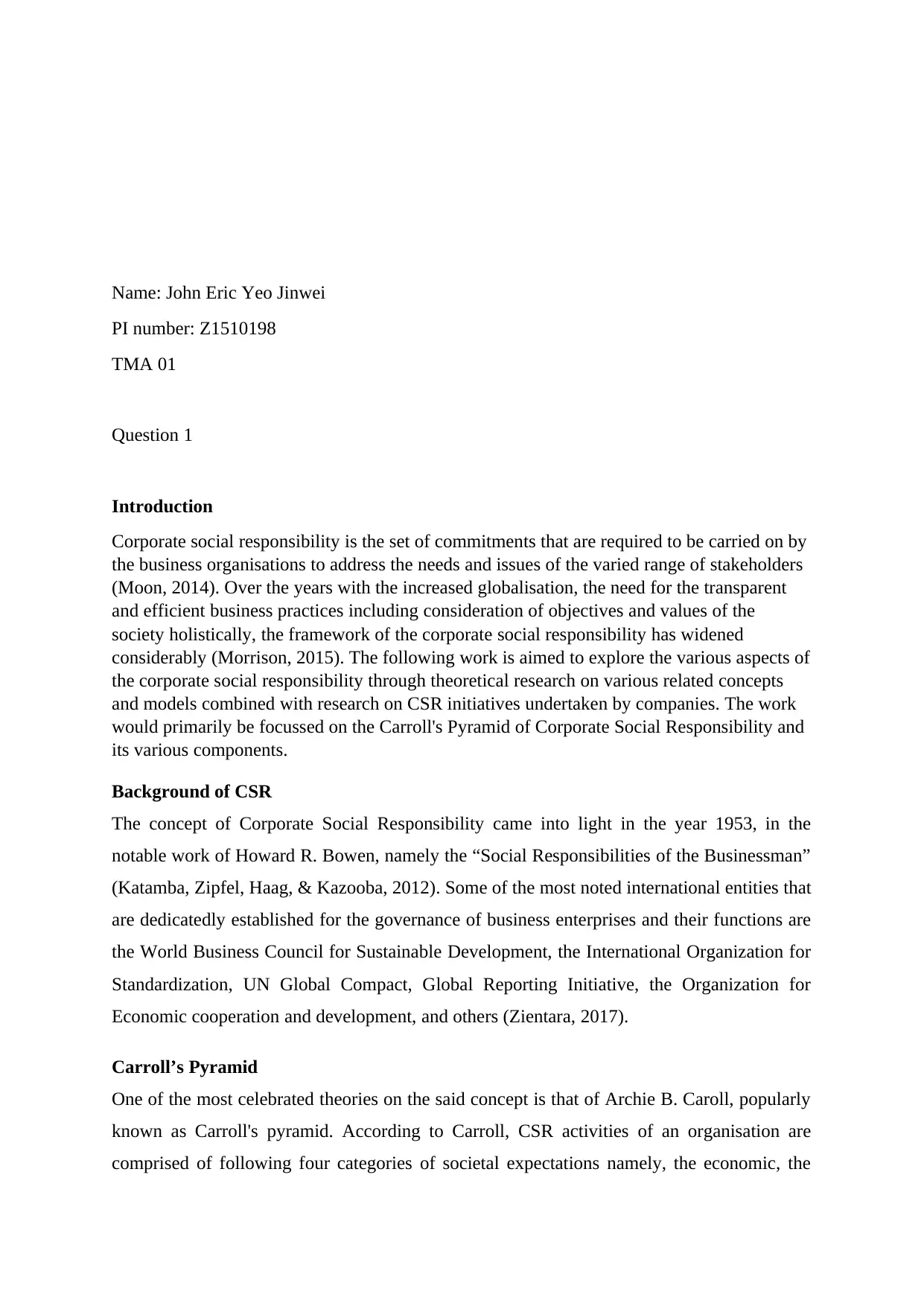
Name: John Eric Yeo Jinwei
PI number: Z1510198
TMA 01
Question 1
Introduction
Corporate social responsibility is the set of commitments that are required to be carried on by
the business organisations to address the needs and issues of the varied range of stakeholders
(Moon, 2014). Over the years with the increased globalisation, the need for the transparent
and efficient business practices including consideration of objectives and values of the
society holistically, the framework of the corporate social responsibility has widened
considerably (Morrison, 2015). The following work is aimed to explore the various aspects of
the corporate social responsibility through theoretical research on various related concepts
and models combined with research on CSR initiatives undertaken by companies. The work
would primarily be focussed on the Carroll's Pyramid of Corporate Social Responsibility and
its various components.
Background of CSR
The concept of Corporate Social Responsibility came into light in the year 1953, in the
notable work of Howard R. Bowen, namely the “Social Responsibilities of the Businessman”
(Katamba, Zipfel, Haag, & Kazooba, 2012). Some of the most noted international entities that
are dedicatedly established for the governance of business enterprises and their functions are
the World Business Council for Sustainable Development, the International Organization for
Standardization, UN Global Compact, Global Reporting Initiative, the Organization for
Economic cooperation and development, and others (Zientara, 2017).
Carroll’s Pyramid
One of the most celebrated theories on the said concept is that of Archie B. Caroll, popularly
known as Carroll's pyramid. According to Carroll, CSR activities of an organisation are
comprised of following four categories of societal expectations namely, the economic, the
PI number: Z1510198
TMA 01
Question 1
Introduction
Corporate social responsibility is the set of commitments that are required to be carried on by
the business organisations to address the needs and issues of the varied range of stakeholders
(Moon, 2014). Over the years with the increased globalisation, the need for the transparent
and efficient business practices including consideration of objectives and values of the
society holistically, the framework of the corporate social responsibility has widened
considerably (Morrison, 2015). The following work is aimed to explore the various aspects of
the corporate social responsibility through theoretical research on various related concepts
and models combined with research on CSR initiatives undertaken by companies. The work
would primarily be focussed on the Carroll's Pyramid of Corporate Social Responsibility and
its various components.
Background of CSR
The concept of Corporate Social Responsibility came into light in the year 1953, in the
notable work of Howard R. Bowen, namely the “Social Responsibilities of the Businessman”
(Katamba, Zipfel, Haag, & Kazooba, 2012). Some of the most noted international entities that
are dedicatedly established for the governance of business enterprises and their functions are
the World Business Council for Sustainable Development, the International Organization for
Standardization, UN Global Compact, Global Reporting Initiative, the Organization for
Economic cooperation and development, and others (Zientara, 2017).
Carroll’s Pyramid
One of the most celebrated theories on the said concept is that of Archie B. Caroll, popularly
known as Carroll's pyramid. According to Carroll, CSR activities of an organisation are
comprised of following four categories of societal expectations namely, the economic, the
Paraphrase This Document
Need a fresh take? Get an instant paraphrase of this document with our AI Paraphraser
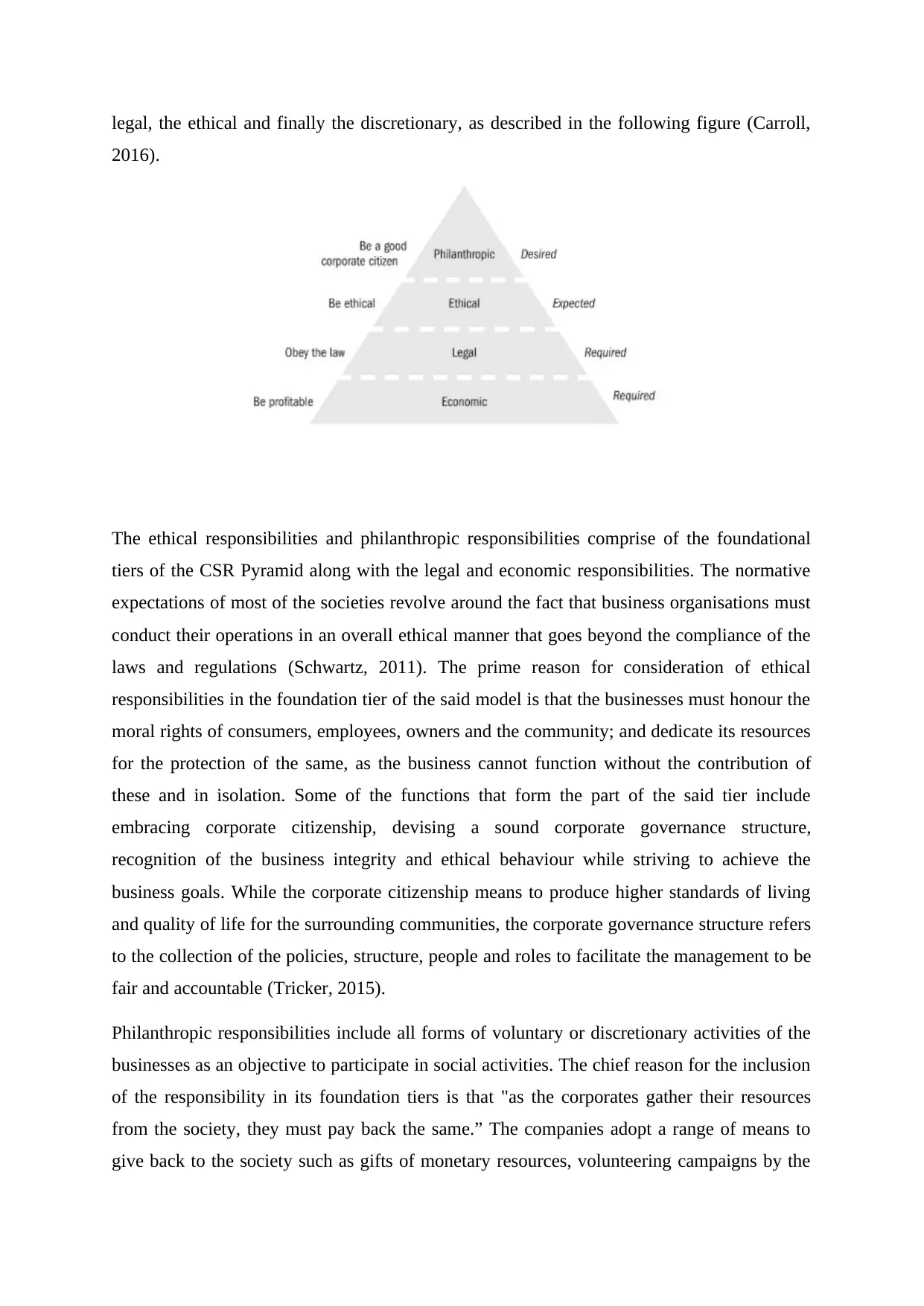
legal, the ethical and finally the discretionary, as described in the following figure (Carroll,
2016).
The ethical responsibilities and philanthropic responsibilities comprise of the foundational
tiers of the CSR Pyramid along with the legal and economic responsibilities. The normative
expectations of most of the societies revolve around the fact that business organisations must
conduct their operations in an overall ethical manner that goes beyond the compliance of the
laws and regulations (Schwartz, 2011). The prime reason for consideration of ethical
responsibilities in the foundation tier of the said model is that the businesses must honour the
moral rights of consumers, employees, owners and the community; and dedicate its resources
for the protection of the same, as the business cannot function without the contribution of
these and in isolation. Some of the functions that form the part of the said tier include
embracing corporate citizenship, devising a sound corporate governance structure,
recognition of the business integrity and ethical behaviour while striving to achieve the
business goals. While the corporate citizenship means to produce higher standards of living
and quality of life for the surrounding communities, the corporate governance structure refers
to the collection of the policies, structure, people and roles to facilitate the management to be
fair and accountable (Tricker, 2015).
Philanthropic responsibilities include all forms of voluntary or discretionary activities of the
businesses as an objective to participate in social activities. The chief reason for the inclusion
of the responsibility in its foundation tiers is that "as the corporates gather their resources
from the society, they must pay back the same.” The companies adopt a range of means to
give back to the society such as gifts of monetary resources, volunteering campaigns by the
2016).
The ethical responsibilities and philanthropic responsibilities comprise of the foundational
tiers of the CSR Pyramid along with the legal and economic responsibilities. The normative
expectations of most of the societies revolve around the fact that business organisations must
conduct their operations in an overall ethical manner that goes beyond the compliance of the
laws and regulations (Schwartz, 2011). The prime reason for consideration of ethical
responsibilities in the foundation tier of the said model is that the businesses must honour the
moral rights of consumers, employees, owners and the community; and dedicate its resources
for the protection of the same, as the business cannot function without the contribution of
these and in isolation. Some of the functions that form the part of the said tier include
embracing corporate citizenship, devising a sound corporate governance structure,
recognition of the business integrity and ethical behaviour while striving to achieve the
business goals. While the corporate citizenship means to produce higher standards of living
and quality of life for the surrounding communities, the corporate governance structure refers
to the collection of the policies, structure, people and roles to facilitate the management to be
fair and accountable (Tricker, 2015).
Philanthropic responsibilities include all forms of voluntary or discretionary activities of the
businesses as an objective to participate in social activities. The chief reason for the inclusion
of the responsibility in its foundation tiers is that "as the corporates gather their resources
from the society, they must pay back the same.” The companies adopt a range of means to
give back to the society such as gifts of monetary resources, volunteering campaigns by the
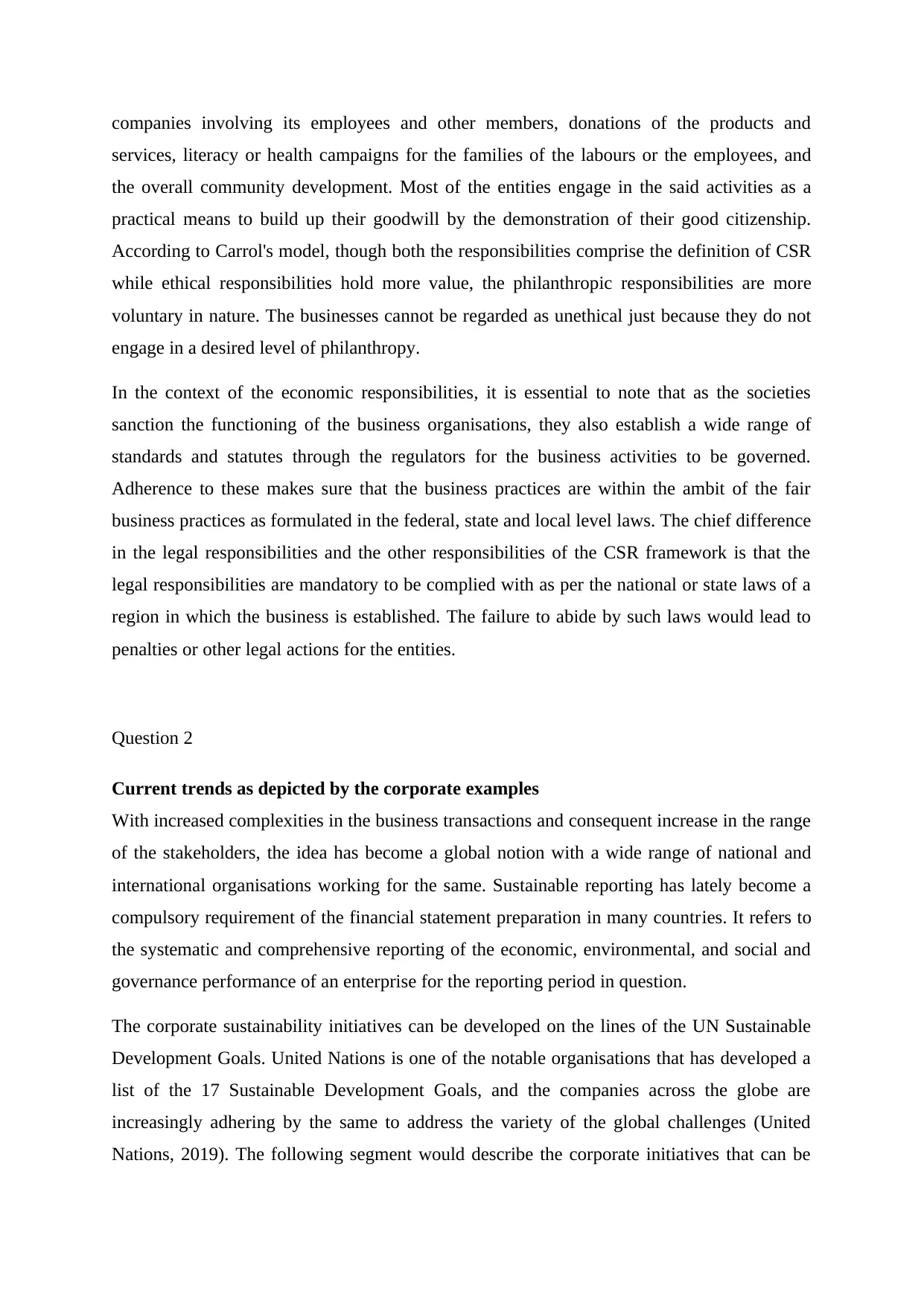
companies involving its employees and other members, donations of the products and
services, literacy or health campaigns for the families of the labours or the employees, and
the overall community development. Most of the entities engage in the said activities as a
practical means to build up their goodwill by the demonstration of their good citizenship.
According to Carrol's model, though both the responsibilities comprise the definition of CSR
while ethical responsibilities hold more value, the philanthropic responsibilities are more
voluntary in nature. The businesses cannot be regarded as unethical just because they do not
engage in a desired level of philanthropy.
In the context of the economic responsibilities, it is essential to note that as the societies
sanction the functioning of the business organisations, they also establish a wide range of
standards and statutes through the regulators for the business activities to be governed.
Adherence to these makes sure that the business practices are within the ambit of the fair
business practices as formulated in the federal, state and local level laws. The chief difference
in the legal responsibilities and the other responsibilities of the CSR framework is that the
legal responsibilities are mandatory to be complied with as per the national or state laws of a
region in which the business is established. The failure to abide by such laws would lead to
penalties or other legal actions for the entities.
Question 2
Current trends as depicted by the corporate examples
With increased complexities in the business transactions and consequent increase in the range
of the stakeholders, the idea has become a global notion with a wide range of national and
international organisations working for the same. Sustainable reporting has lately become a
compulsory requirement of the financial statement preparation in many countries. It refers to
the systematic and comprehensive reporting of the economic, environmental, and social and
governance performance of an enterprise for the reporting period in question.
The corporate sustainability initiatives can be developed on the lines of the UN Sustainable
Development Goals. United Nations is one of the notable organisations that has developed a
list of the 17 Sustainable Development Goals, and the companies across the globe are
increasingly adhering by the same to address the variety of the global challenges (United
Nations, 2019). The following segment would describe the corporate initiatives that can be
services, literacy or health campaigns for the families of the labours or the employees, and
the overall community development. Most of the entities engage in the said activities as a
practical means to build up their goodwill by the demonstration of their good citizenship.
According to Carrol's model, though both the responsibilities comprise the definition of CSR
while ethical responsibilities hold more value, the philanthropic responsibilities are more
voluntary in nature. The businesses cannot be regarded as unethical just because they do not
engage in a desired level of philanthropy.
In the context of the economic responsibilities, it is essential to note that as the societies
sanction the functioning of the business organisations, they also establish a wide range of
standards and statutes through the regulators for the business activities to be governed.
Adherence to these makes sure that the business practices are within the ambit of the fair
business practices as formulated in the federal, state and local level laws. The chief difference
in the legal responsibilities and the other responsibilities of the CSR framework is that the
legal responsibilities are mandatory to be complied with as per the national or state laws of a
region in which the business is established. The failure to abide by such laws would lead to
penalties or other legal actions for the entities.
Question 2
Current trends as depicted by the corporate examples
With increased complexities in the business transactions and consequent increase in the range
of the stakeholders, the idea has become a global notion with a wide range of national and
international organisations working for the same. Sustainable reporting has lately become a
compulsory requirement of the financial statement preparation in many countries. It refers to
the systematic and comprehensive reporting of the economic, environmental, and social and
governance performance of an enterprise for the reporting period in question.
The corporate sustainability initiatives can be developed on the lines of the UN Sustainable
Development Goals. United Nations is one of the notable organisations that has developed a
list of the 17 Sustainable Development Goals, and the companies across the globe are
increasingly adhering by the same to address the variety of the global challenges (United
Nations, 2019). The following segment would describe the corporate initiatives that can be
⊘ This is a preview!⊘
Do you want full access?
Subscribe today to unlock all pages.

Trusted by 1+ million students worldwide
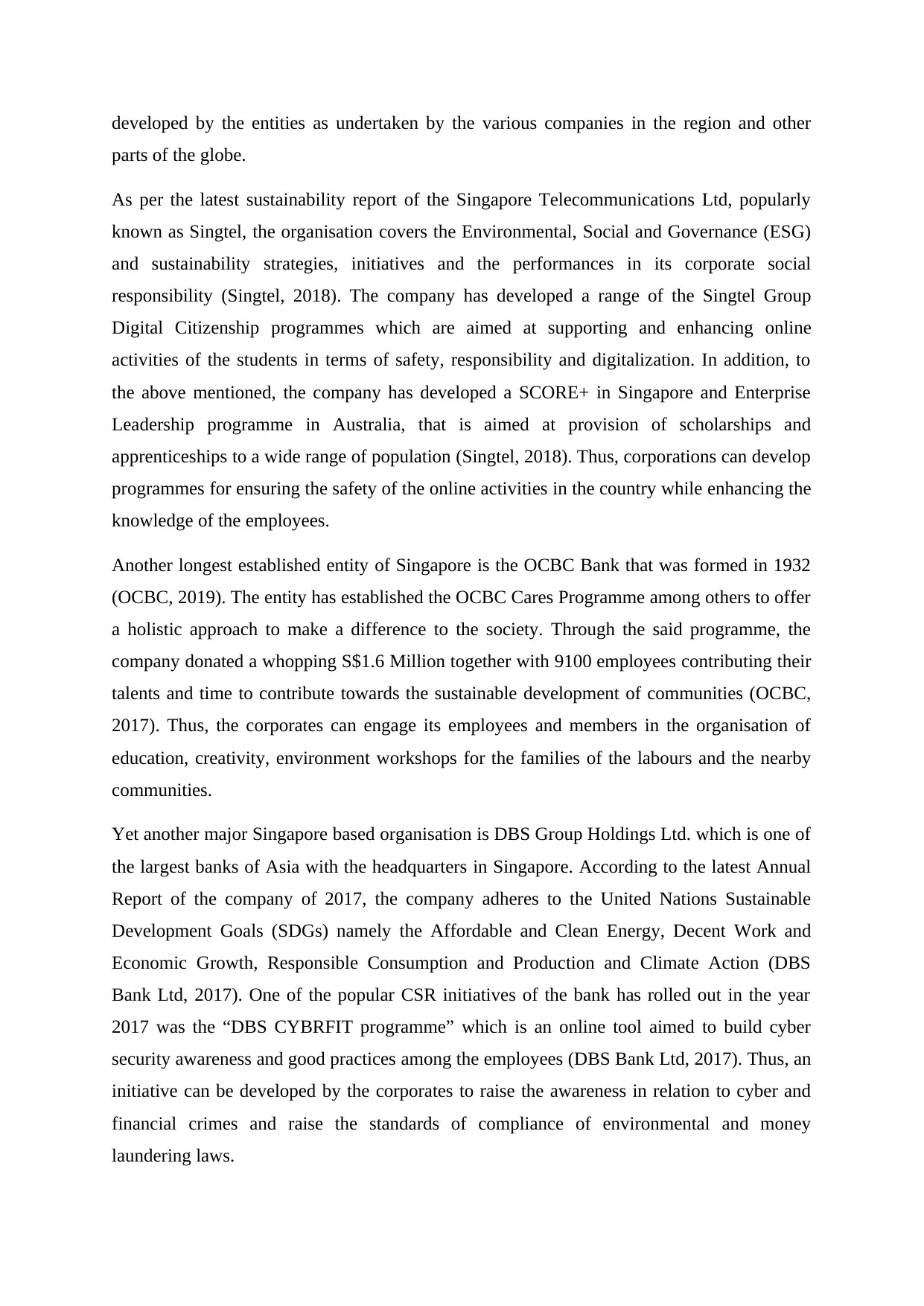
developed by the entities as undertaken by the various companies in the region and other
parts of the globe.
As per the latest sustainability report of the Singapore Telecommunications Ltd, popularly
known as Singtel, the organisation covers the Environmental, Social and Governance (ESG)
and sustainability strategies, initiatives and the performances in its corporate social
responsibility (Singtel, 2018). The company has developed a range of the Singtel Group
Digital Citizenship programmes which are aimed at supporting and enhancing online
activities of the students in terms of safety, responsibility and digitalization. In addition, to
the above mentioned, the company has developed a SCORE+ in Singapore and Enterprise
Leadership programme in Australia, that is aimed at provision of scholarships and
apprenticeships to a wide range of population (Singtel, 2018). Thus, corporations can develop
programmes for ensuring the safety of the online activities in the country while enhancing the
knowledge of the employees.
Another longest established entity of Singapore is the OCBC Bank that was formed in 1932
(OCBC, 2019). The entity has established the OCBC Cares Programme among others to offer
a holistic approach to make a difference to the society. Through the said programme, the
company donated a whopping S$1.6 Million together with 9100 employees contributing their
talents and time to contribute towards the sustainable development of communities (OCBC,
2017). Thus, the corporates can engage its employees and members in the organisation of
education, creativity, environment workshops for the families of the labours and the nearby
communities.
Yet another major Singapore based organisation is DBS Group Holdings Ltd. which is one of
the largest banks of Asia with the headquarters in Singapore. According to the latest Annual
Report of the company of 2017, the company adheres to the United Nations Sustainable
Development Goals (SDGs) namely the Affordable and Clean Energy, Decent Work and
Economic Growth, Responsible Consumption and Production and Climate Action (DBS
Bank Ltd, 2017). One of the popular CSR initiatives of the bank has rolled out in the year
2017 was the “DBS CYBRFIT programme” which is an online tool aimed to build cyber
security awareness and good practices among the employees (DBS Bank Ltd, 2017). Thus, an
initiative can be developed by the corporates to raise the awareness in relation to cyber and
financial crimes and raise the standards of compliance of environmental and money
laundering laws.
parts of the globe.
As per the latest sustainability report of the Singapore Telecommunications Ltd, popularly
known as Singtel, the organisation covers the Environmental, Social and Governance (ESG)
and sustainability strategies, initiatives and the performances in its corporate social
responsibility (Singtel, 2018). The company has developed a range of the Singtel Group
Digital Citizenship programmes which are aimed at supporting and enhancing online
activities of the students in terms of safety, responsibility and digitalization. In addition, to
the above mentioned, the company has developed a SCORE+ in Singapore and Enterprise
Leadership programme in Australia, that is aimed at provision of scholarships and
apprenticeships to a wide range of population (Singtel, 2018). Thus, corporations can develop
programmes for ensuring the safety of the online activities in the country while enhancing the
knowledge of the employees.
Another longest established entity of Singapore is the OCBC Bank that was formed in 1932
(OCBC, 2019). The entity has established the OCBC Cares Programme among others to offer
a holistic approach to make a difference to the society. Through the said programme, the
company donated a whopping S$1.6 Million together with 9100 employees contributing their
talents and time to contribute towards the sustainable development of communities (OCBC,
2017). Thus, the corporates can engage its employees and members in the organisation of
education, creativity, environment workshops for the families of the labours and the nearby
communities.
Yet another major Singapore based organisation is DBS Group Holdings Ltd. which is one of
the largest banks of Asia with the headquarters in Singapore. According to the latest Annual
Report of the company of 2017, the company adheres to the United Nations Sustainable
Development Goals (SDGs) namely the Affordable and Clean Energy, Decent Work and
Economic Growth, Responsible Consumption and Production and Climate Action (DBS
Bank Ltd, 2017). One of the popular CSR initiatives of the bank has rolled out in the year
2017 was the “DBS CYBRFIT programme” which is an online tool aimed to build cyber
security awareness and good practices among the employees (DBS Bank Ltd, 2017). Thus, an
initiative can be developed by the corporates to raise the awareness in relation to cyber and
financial crimes and raise the standards of compliance of environmental and money
laundering laws.
Paraphrase This Document
Need a fresh take? Get an instant paraphrase of this document with our AI Paraphraser
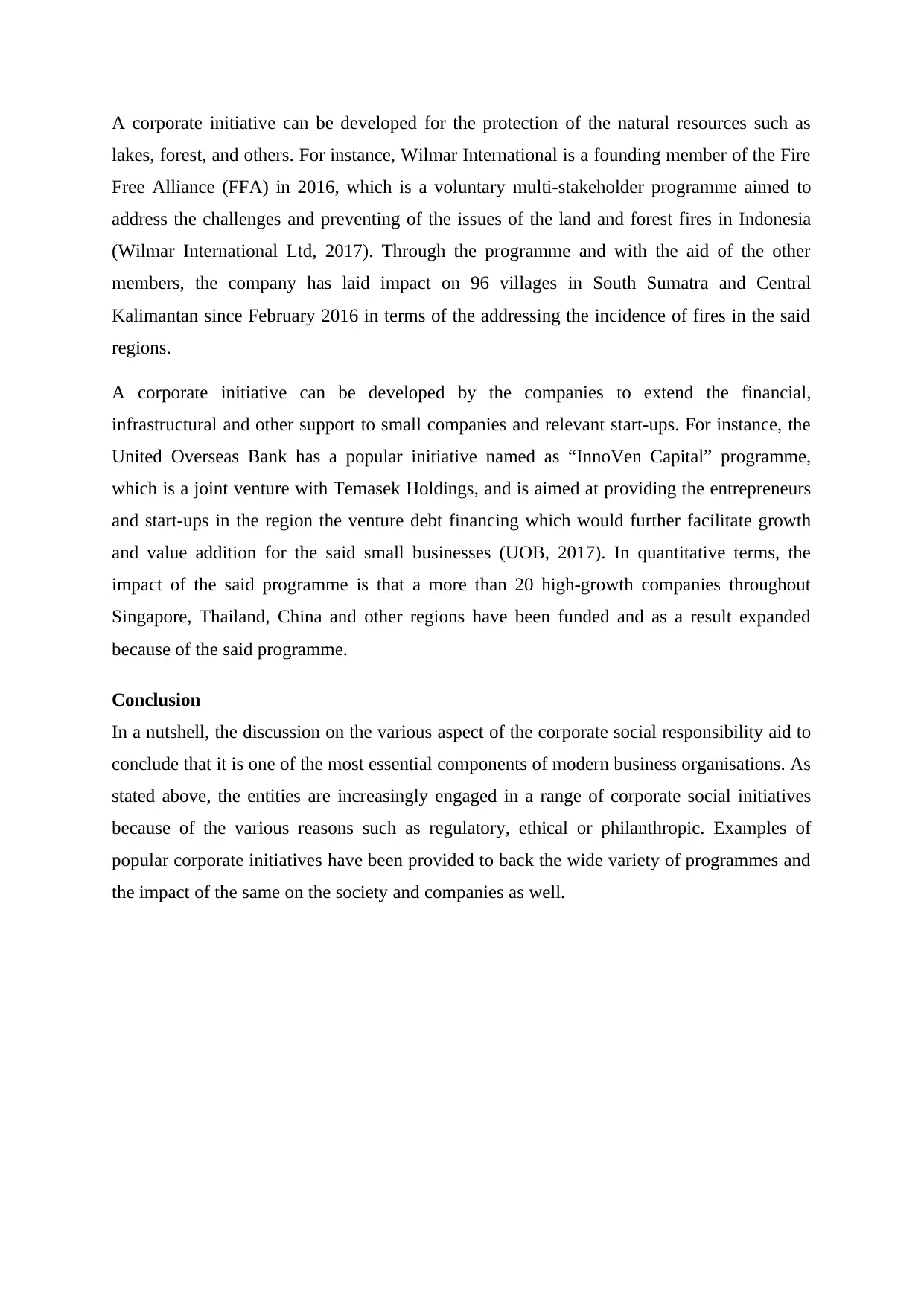
A corporate initiative can be developed for the protection of the natural resources such as
lakes, forest, and others. For instance, Wilmar International is a founding member of the Fire
Free Alliance (FFA) in 2016, which is a voluntary multi-stakeholder programme aimed to
address the challenges and preventing of the issues of the land and forest fires in Indonesia
(Wilmar International Ltd, 2017). Through the programme and with the aid of the other
members, the company has laid impact on 96 villages in South Sumatra and Central
Kalimantan since February 2016 in terms of the addressing the incidence of fires in the said
regions.
A corporate initiative can be developed by the companies to extend the financial,
infrastructural and other support to small companies and relevant start-ups. For instance, the
United Overseas Bank has a popular initiative named as “InnoVen Capital” programme,
which is a joint venture with Temasek Holdings, and is aimed at providing the entrepreneurs
and start-ups in the region the venture debt financing which would further facilitate growth
and value addition for the said small businesses (UOB, 2017). In quantitative terms, the
impact of the said programme is that a more than 20 high-growth companies throughout
Singapore, Thailand, China and other regions have been funded and as a result expanded
because of the said programme.
Conclusion
In a nutshell, the discussion on the various aspect of the corporate social responsibility aid to
conclude that it is one of the most essential components of modern business organisations. As
stated above, the entities are increasingly engaged in a range of corporate social initiatives
because of the various reasons such as regulatory, ethical or philanthropic. Examples of
popular corporate initiatives have been provided to back the wide variety of programmes and
the impact of the same on the society and companies as well.
lakes, forest, and others. For instance, Wilmar International is a founding member of the Fire
Free Alliance (FFA) in 2016, which is a voluntary multi-stakeholder programme aimed to
address the challenges and preventing of the issues of the land and forest fires in Indonesia
(Wilmar International Ltd, 2017). Through the programme and with the aid of the other
members, the company has laid impact on 96 villages in South Sumatra and Central
Kalimantan since February 2016 in terms of the addressing the incidence of fires in the said
regions.
A corporate initiative can be developed by the companies to extend the financial,
infrastructural and other support to small companies and relevant start-ups. For instance, the
United Overseas Bank has a popular initiative named as “InnoVen Capital” programme,
which is a joint venture with Temasek Holdings, and is aimed at providing the entrepreneurs
and start-ups in the region the venture debt financing which would further facilitate growth
and value addition for the said small businesses (UOB, 2017). In quantitative terms, the
impact of the said programme is that a more than 20 high-growth companies throughout
Singapore, Thailand, China and other regions have been funded and as a result expanded
because of the said programme.
Conclusion
In a nutshell, the discussion on the various aspect of the corporate social responsibility aid to
conclude that it is one of the most essential components of modern business organisations. As
stated above, the entities are increasingly engaged in a range of corporate social initiatives
because of the various reasons such as regulatory, ethical or philanthropic. Examples of
popular corporate initiatives have been provided to back the wide variety of programmes and
the impact of the same on the society and companies as well.
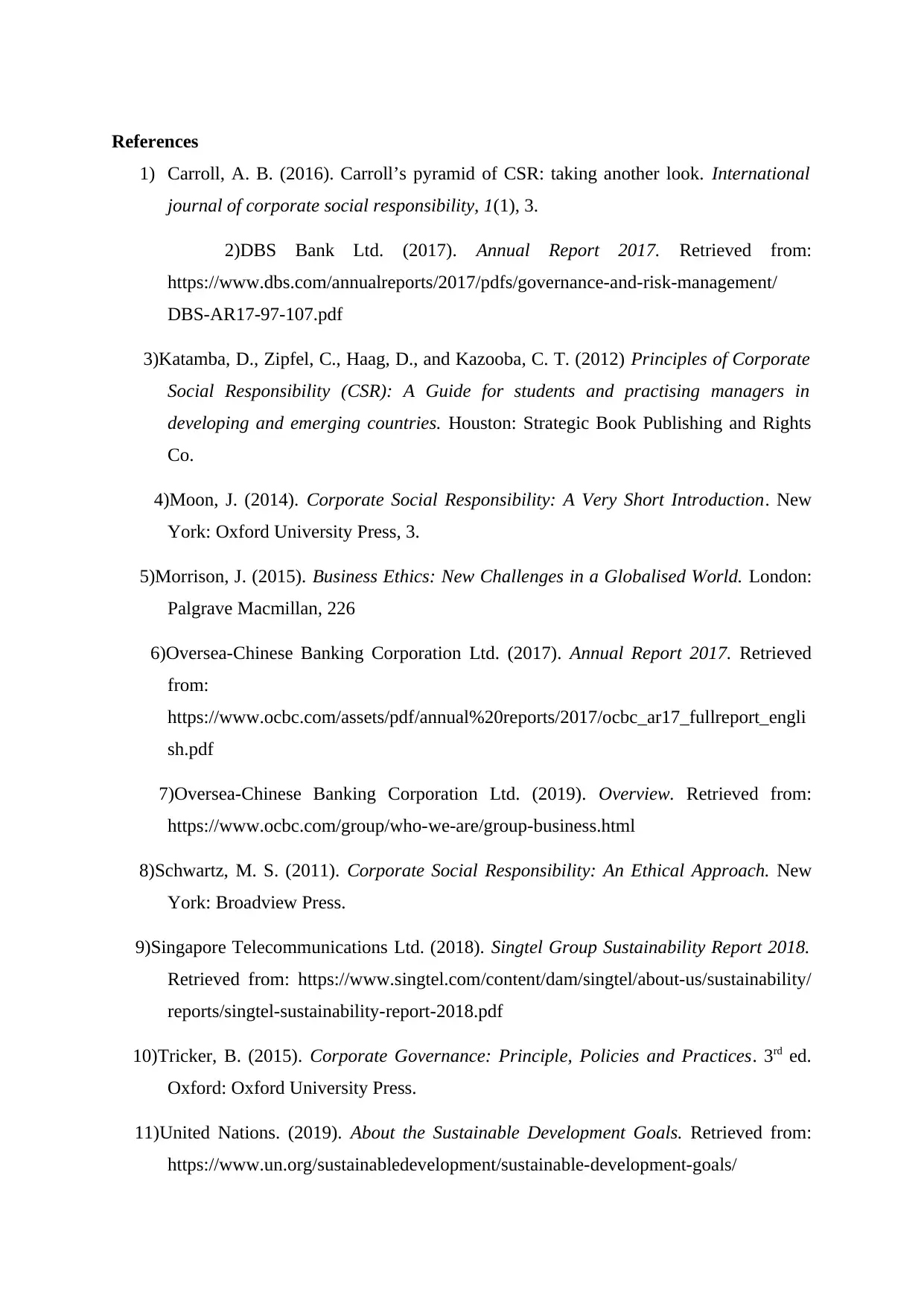
References
1) Carroll, A. B. (2016). Carroll’s pyramid of CSR: taking another look. International
journal of corporate social responsibility, 1(1), 3.
2)DBS Bank Ltd. (2017). Annual Report 2017. Retrieved from:
https://www.dbs.com/annualreports/2017/pdfs/governance-and-risk-management/
DBS-AR17-97-107.pdf
3)Katamba, D., Zipfel, C., Haag, D., and Kazooba, C. T. (2012) Principles of Corporate
Social Responsibility (CSR): A Guide for students and practising managers in
developing and emerging countries. Houston: Strategic Book Publishing and Rights
Co.
4)Moon, J. (2014). Corporate Social Responsibility: A Very Short Introduction. New
York: Oxford University Press, 3.
5)Morrison, J. (2015). Business Ethics: New Challenges in a Globalised World. London:
Palgrave Macmillan, 226
6)Oversea-Chinese Banking Corporation Ltd. (2017). Annual Report 2017. Retrieved
from:
https://www.ocbc.com/assets/pdf/annual%20reports/2017/ocbc_ar17_fullreport_engli
sh.pdf
7)Oversea-Chinese Banking Corporation Ltd. (2019). Overview. Retrieved from:
https://www.ocbc.com/group/who-we-are/group-business.html
8)Schwartz, M. S. (2011). Corporate Social Responsibility: An Ethical Approach. New
York: Broadview Press.
9)Singapore Telecommunications Ltd. (2018). Singtel Group Sustainability Report 2018.
Retrieved from: https://www.singtel.com/content/dam/singtel/about-us/sustainability/
reports/singtel-sustainability-report-2018.pdf
10)Tricker, B. (2015). Corporate Governance: Principle, Policies and Practices. 3rd ed.
Oxford: Oxford University Press.
11)United Nations. (2019). About the Sustainable Development Goals. Retrieved from:
https://www.un.org/sustainabledevelopment/sustainable-development-goals/
1) Carroll, A. B. (2016). Carroll’s pyramid of CSR: taking another look. International
journal of corporate social responsibility, 1(1), 3.
2)DBS Bank Ltd. (2017). Annual Report 2017. Retrieved from:
https://www.dbs.com/annualreports/2017/pdfs/governance-and-risk-management/
DBS-AR17-97-107.pdf
3)Katamba, D., Zipfel, C., Haag, D., and Kazooba, C. T. (2012) Principles of Corporate
Social Responsibility (CSR): A Guide for students and practising managers in
developing and emerging countries. Houston: Strategic Book Publishing and Rights
Co.
4)Moon, J. (2014). Corporate Social Responsibility: A Very Short Introduction. New
York: Oxford University Press, 3.
5)Morrison, J. (2015). Business Ethics: New Challenges in a Globalised World. London:
Palgrave Macmillan, 226
6)Oversea-Chinese Banking Corporation Ltd. (2017). Annual Report 2017. Retrieved
from:
https://www.ocbc.com/assets/pdf/annual%20reports/2017/ocbc_ar17_fullreport_engli
sh.pdf
7)Oversea-Chinese Banking Corporation Ltd. (2019). Overview. Retrieved from:
https://www.ocbc.com/group/who-we-are/group-business.html
8)Schwartz, M. S. (2011). Corporate Social Responsibility: An Ethical Approach. New
York: Broadview Press.
9)Singapore Telecommunications Ltd. (2018). Singtel Group Sustainability Report 2018.
Retrieved from: https://www.singtel.com/content/dam/singtel/about-us/sustainability/
reports/singtel-sustainability-report-2018.pdf
10)Tricker, B. (2015). Corporate Governance: Principle, Policies and Practices. 3rd ed.
Oxford: Oxford University Press.
11)United Nations. (2019). About the Sustainable Development Goals. Retrieved from:
https://www.un.org/sustainabledevelopment/sustainable-development-goals/
⊘ This is a preview!⊘
Do you want full access?
Subscribe today to unlock all pages.

Trusted by 1+ million students worldwide
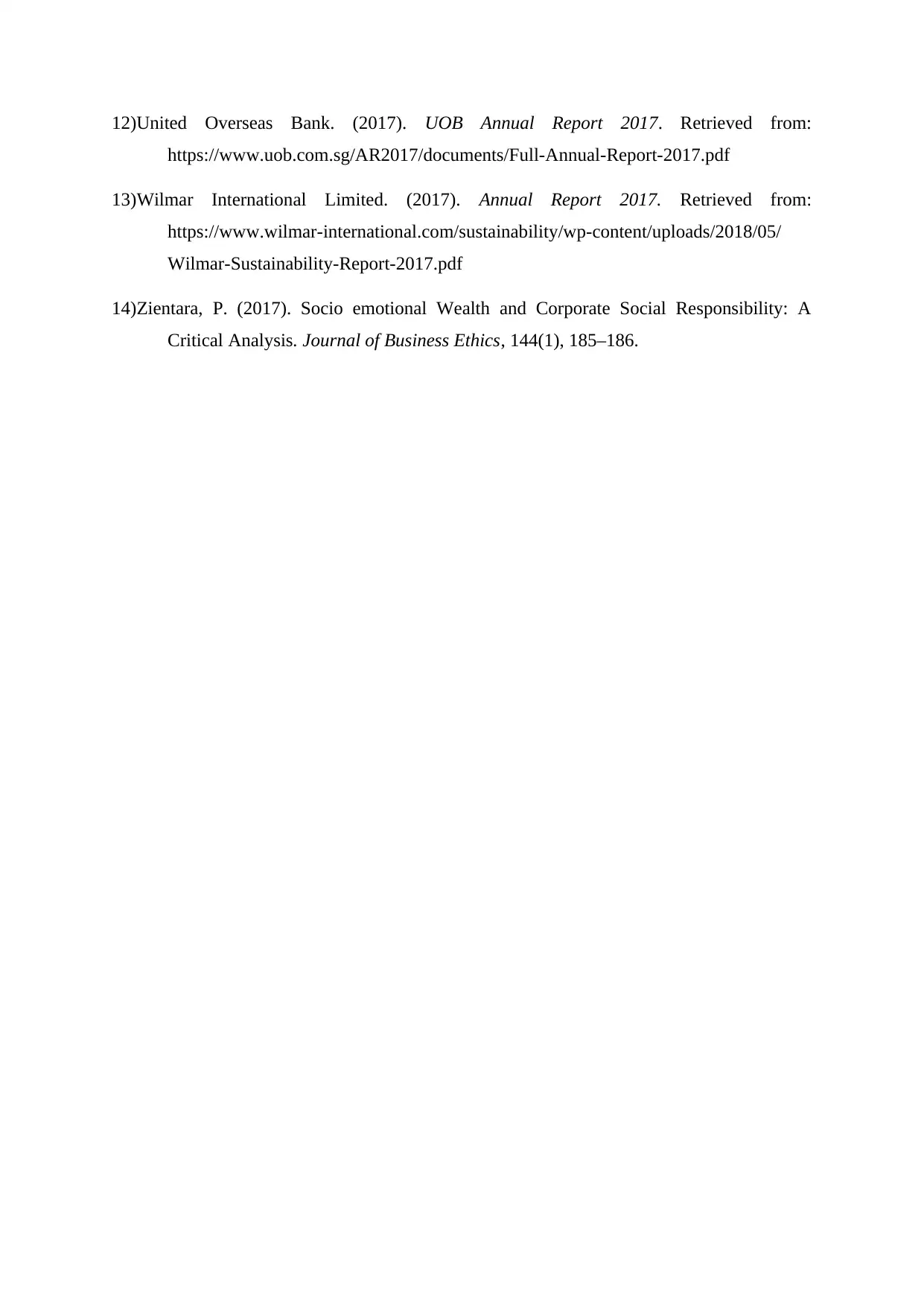
12)United Overseas Bank. (2017). UOB Annual Report 2017. Retrieved from:
https://www.uob.com.sg/AR2017/documents/Full-Annual-Report-2017.pdf
13)Wilmar International Limited. (2017). Annual Report 2017. Retrieved from:
https://www.wilmar-international.com/sustainability/wp-content/uploads/2018/05/
Wilmar-Sustainability-Report-2017.pdf
14)Zientara, P. (2017). Socio emotional Wealth and Corporate Social Responsibility: A
Critical Analysis. Journal of Business Ethics, 144(1), 185–186.
https://www.uob.com.sg/AR2017/documents/Full-Annual-Report-2017.pdf
13)Wilmar International Limited. (2017). Annual Report 2017. Retrieved from:
https://www.wilmar-international.com/sustainability/wp-content/uploads/2018/05/
Wilmar-Sustainability-Report-2017.pdf
14)Zientara, P. (2017). Socio emotional Wealth and Corporate Social Responsibility: A
Critical Analysis. Journal of Business Ethics, 144(1), 185–186.
1 out of 7
Related Documents
Your All-in-One AI-Powered Toolkit for Academic Success.
+13062052269
info@desklib.com
Available 24*7 on WhatsApp / Email
![[object Object]](/_next/static/media/star-bottom.7253800d.svg)
Unlock your academic potential
Copyright © 2020–2025 A2Z Services. All Rights Reserved. Developed and managed by ZUCOL.





